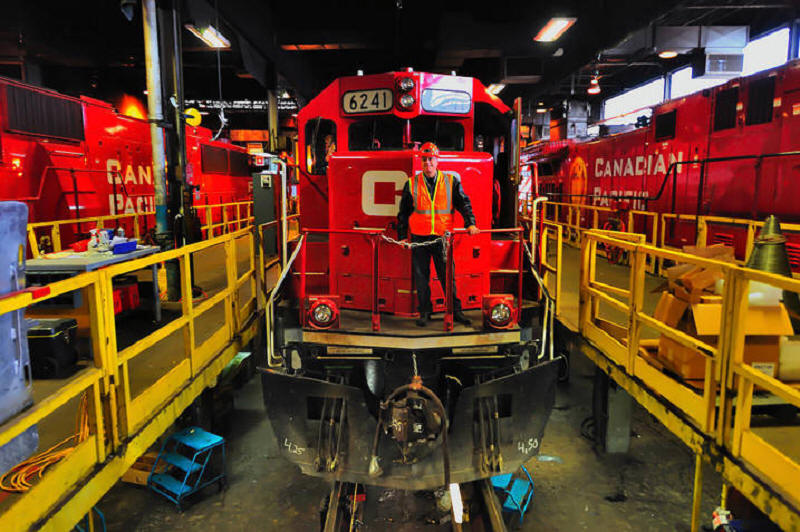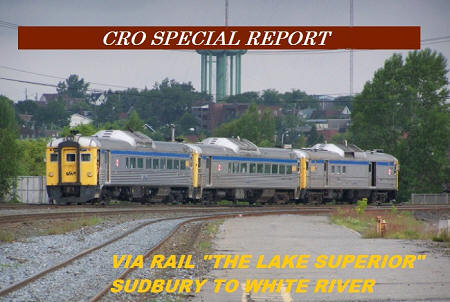LETTERS TO THE EDITOR
LETTERS TO THE EDITOR: We invite you to send your questions and comments: Email us at: editor@canadianrailwayobservations.com Dear Sir.
I have just finished reading the Special Report of the Northlander. The Report is very well done. In fact. I would say it is exceptional. It is often very difficult to cover such an emotional issue. To say that we experienced a loss is an understatement. It is almost impossible to understand why we continue to destroy the very fabric of our beautiful country. To relate such decisions to money is nonsense.
CRO helps us to understand. More than presenting details of Railway interest, you and many others help us to realize how important the Rails are to our well-being.
Thank You! I consider it a privilege to be one of your 'subscribers.' Thanks again,
Paul and Robyn - Ontario
Hello again Will, Thank you for helping me. My wife had a look at the banner you created for Caboose Coffee and we agree that you’ve given my blog a very classy banner. I’ve tried to ‘re-size’ the CRO banner on my blog, but I haven’t been successful with that. I have always felt that it is too small and would like to make it larger, but I think the determining factor might be the “side-bar” format of my blog. I’ll have another poke at it when I get feeling better after my surgery…, likely a couple of weeks from now. Thank you for making room for me on CRO… I’m pleased to be so honored. Cheers,
Bruce Harvey, Caboose Coffee Blog British Columbia
Thank you Bruce! Editor
Dear William,
I was pleased to read Michael's review and assessment of my book, "Seasons of Trains". Clearly I think that he enjoyed the book, and the reader's enjoyment was of course my ultimate aim.
I would like to make a couple of brief comments regarding the review. Firstly, just a "picky" point is the fact there were a handful of Mountain Division pictures, the Crawford Notch shot to which he referred (which was a westbound), a shot at East St Johnsbury, and a couple shots on the Beecher Falls branch, which while not on the Crawford Notch line were on the Mountain division and of course, the dust jacket cover shot, while not in the more well known area of the line, White Rock (Gorham) Maine, was indeed on the Mountain Subdivision.
The second point is a bit less "picky". The lack of pictures on the Mountain Division was a conscious choice. The remarkable features of the crossing of the White Mountains has been shown many times in many places. In fact books have been written on the Mountain Division itself. And while it is very interesting and photogenic, and was a real challenge to dispatch, it has long been my contention that there was a lot more to the Maine Central than the "Mountain". Many of the company's other interesting lines have been overlooked, overshadowed if you will, by the Mountain. I wanted to give space to some of those less well covered lines.
I would add that a very limited number of copies are still available. You can purchase one directly from me (I will autograph it if you like) or from the website, which appears below my signature.
George Pitarys See my book Seasons of Trains http://railroadexplorer.com/seasons
Thanks George! Editor Hi Will.
In Windsor, Ontario June 5th, 2012, I shot this video of my Dad (Bill Magone)
who was retiring from CP. It was his last time at the throttle on this
occasion moving his SD40-2 passing through his retirement banner!
Thank you, Windsor. ON
Hi Will,
I wish to thank Webmaster Nathan Brown for Co-Editing and taking over CRO for much of this month while I was unavailable with computer issues, and outside work. Nathan did a superb job! The ONR Northlander Report was great as well Nathan! Thanks! As well a tip of my had and bow to CRO Production Manager Michael Berry for his great work administrating CRO Facebook while I was off, Thanks Guys!
Francois Jolin, Thomas Blampied and myself visited St-Luc Diesel Shop in Montreal, QC on October 17th and we have a full report of the power on hand in our November 1st issue of CRO (CP section). My good buddy Francois Jolin snapped this shot of your editor surrounded by CP Candy Apple Red SD60’s getting PTC mods inside the shop.
I received this in October: A railway connecting Alaska to the lower 48 states has never been as close to realization as it is at present. Only $4.5 million, to enable the securing of an operating line of credit for a feasibility study, is needed for the Canadian company Generating for Seven Generations, Ltd. (G7G) to launch this long awaited project. Anchorage, Alaska (PRWEB) October 25, 2012 It has been assumed that a railroad to Alaska cannot be built by Americans or Canadians on their own, despite the fact that Interior Alaska and Canada residents face each winter season with crushing energy, food and materials costs—due to the reality that all freight must be shipped either by air or by sea. Bruce Carr, Director of Strategic Planning for the Alaska Railroad Corporation, said in July “It's a mind-boggling project for the American side, and the federal government would have to help support it.” But federal government support hasn’t been offered even though a direct railway connection would generate hundreds of thousands of jobs during and after construction, thus aiding our fragile U.S. economy. All the latest plans of developers to bring a railroad through to Alaska are therefore based on the idea of incorporating it into a global intercontinental railway project with Russia—together with the construction of a tunnel under the Bering Strait. This would make project construction more profitable for private investors. But even this faces its own difficulties, like the inability of past Russian and U.S. leaders to sign a joint treaty. Finding investors who will pay up to $100 billion for the laying of 2,400 miles of rail through undeveloped regions of Siberia to the Chukotka Peninsula in Russia, plus 3,000 more miles in the U.S. and Canada, and digging a tunnel under the Bering Strait, is also a challenge. Support for a Canada-Alaska railroad, however, grows along with each new rise in the price of oil, the growing demand in Asia for new oil sources, and the simple fact that Canadian natural resources—especially in the Western Provinces of British Columbia, Alberta and Saskatchewan as well as the Yukon Territory—have difficult access to Pacific ports. Many Canadians, led by the First Nations, are in favour of extraction and export of natural resources. But many are also opposed to oil tankers sailing from Canadian ports. Any proposal advocating supertanker expansion in BC coastal waters are fought by First Nations, which seek to protect their territory using traditional, cultural and legal arguments. Under the guidance of Canadian businessmen Matt Vickers, Ward Kemerer, Tom Jackson and Len Wilson, G7G Ltd. continues to plan for a rail line transporting oil sands from the Ft. McMurray and Peace River regions of Alberta to a point near Delta Junction, Alaska. There, oil would move into the Trans-Alaska Pipeline System (TAPS) for transport to the oil terminal in Valdez and loaded into tankers. “This rail project may be made economically viable because of the controversy of both the Keystone pipeline, designed to move Canadian oil-sands products to the Gulf Coast, and the plans to turn Prince Rupert and/or Vancouver, BC into oil supertanker terminals for shipment of oil sands products to Asia, California U.S. and European markets,” says Luke Hopkins, Mayor of Fairbanks North Star Borough in support of the G7G initiative. G7G is also receiving enthusiastic support for the project from the Alaska and Yukon governments, and looks forward to First Nations of Canada, Tribes of the United States, and Government support in addressing Aboriginal Title and Rights concerns. G7G has likewise formed a partnership with the reputable engineering firm AECOM to verify that the rail project is viable. AECOM is a global provider of technical and management support services to a broad range of industries including transportation, facilities, environmental, energy, water—as well as to government. AECOM is ranked as the #1 Design Firm in the 2011 Engineering News Record; and they are ranked by Ethisphere as one of the world’s 110 Most Ethical Companies. AECOM has produced a scoping document using industry proven methodology confirming that the G7G rail project is indeed viable. It shows that G7G will be able to transport oil sands products competitively in all aspects—including economics, timelines and most importantly, safety. Project viability was analyzed assuming an export rate of one million barrels per day (bpd) of oil products. A double-track, 1,632 mile purpose-built railway would be built from Canada to Delta Junction, Alaska capable of transporting over 4 million bpd of oil products at a total estimated cost of $10.4 billion. The conservative revenue estimate is $3.5 billion per year, with $2.5 billion of this based solely on oil transport at one million barrels per day. Near Delta Junction, a Canadian railroad would be connected with the single-track Alaskan railroad which is itself now under construction by Kiewit Infrastructure Group. This firm is presently also erecting a bridge over the Tanana River as a part of an 80-mile Northern Rail Extension Project of Alaska Railroad, from the city of North Pole. “Currently, TAPS is running at less than one-third of its designed capacity of 1.8 million to 2 million barrels per day. A pipeline on wheels could deliver to Alaska enough oil to fill the pipeline to capacity, as well as utilize the excess capacity of the Flint Hills Refinery near Fairbanks for refining into ultra-low sulfur aviation, maritime, and home heating fuels,” adds Luke Hopkins. A rail connection will also allow for oversized, super-heavy dimensional loads of specialized oil sands upgrader cargo, through Alaskan ports such as Seward, Whittier, Anchorage and Port MacKenzie. This is a troublesome bottleneck issue for critical equipment en route to Alberta. For example, port access in Alaska will allow Asian shippers to unload their cargo bound for U.S. and Canadian markets closer to the point of origin—greatly speeding up delivery and turn-around times. Furthermore, connection of rail to Alaskan ports will greatly enhance the economic viability and development of vast mineral deposits located on First Nation and Alaska Native lands along the rail corridor. The economic, social, and strategic value of this project cannot be overstated; this rail-line will be the key factor in development and economic sustainability for peoples along the entire route. Sean Parnell, the Governor of Alaska, wrote to G7G in July that “the potential economic benefits of a rail link for both Alaska and Canada have been a vision as far back as the Harriman Expedition in the mid-1800s. Tremendous mineral wealth also exists along and near the rail corridor. “ “In 2005 Alaska and Yukon agreed to jointly contribute $5 million towards Phase I (http://www.interbering.com/Feasibility-Study-Reports.html ) of an Alaska-Canada rail link study,” he added. “Just this year, the legislature appropriated an additional $1.1 million to the University of Alaska to begin Phase II of that study. Interest by my administration and the legislature for potential economic benefits of a rail link remains strong, and this work will be complimentary to the G7G feasibility efforts.” “The two-track, Canadian-Alaska railroad will be built by the year 2018, if we get the required $4.5 million and start working now,” says Ward Kemerer, G7G Director. The construction of a Canada-Alaska railroad would have an additional impact on the proposed America-Russia railroad. If this connection happens soon, then the part on the American continent of international track (a 1,300-mile bit between Fairbanks and the Bering Strait) can be completed by 2024—six or more years earlier than the Russian railroad to the coast of the Bering Strait from Yakutsk. That might give the U.S. an opportunity to dig the entire 64-mile Bering Strait tunnel using its own financing and labor force. This could potentially give more control over key aspects such as tunnel maintenance, security, customs and operation schedules—including land on the Russian side to house workers, etc. G7G, the planner of the Canada-Alaska railroad, has already secured lending for the $8-12 billion rail line build, and is preparing to conduct a feasibility study to verify the business plan (anticipated cost of $40 million). A secured lender will front $100 million of their corporate bonds to be insured at $4.5 million to enable G7G to secure an operating line of credit in order to conduct the feasibility study. The security for the $4.5 million is an additional $10 million bond. G7G is seeking $4.5 million to complete this portion of the project. G7G will repay the $4.5 million within 45 days plus generous interest. For details please contact G7G CEO Matt Vickers at matt@mattvickers.com or by phone: 604-261-3733 (cell: 778-239-1440). Website: http://www.unfnrailco.com . Fyodor Soloview soloview@gci.netCRO MODELER’S CORNER: CRO has a new Modeler’s Corner Editor, Barry Oldham from The Train Cellar. Barry has many years experience detailing and painting accurate Canadian railroad locomotive and car models. We welcome him aboard! We invite you all to submit your railroad model photos to me for consideration and posting on Modeler’s Corner. CRO PHOTO CONTEST: Craig McDowell of MCM Rail Videos is now sponsoring the CRO monthly photo contest. Craig will Judge all the photos entered each month and he alone will choose the winning entry which will be awarded the DVD of their choice. Please send submissions to Craig at: iloverailroads@me.com CRO FACEBOOK: With CRO FACEBOOK over 3,400 Fans we suggest you visit if you have not yet done so. Feel free to post your own photos on the page and participate in our QUESTION quizzes. We thank all of you who support our efforts! See the CRO page here: http://www.facebook.com/pages/Canadian-Railway-Observations-CRO/287488550757 HAVE A CRO PASSWORD OR PAYMENT ISSUE? Email William Baird at editor@canadianrailwayobservations.com, Please understand we are busy sending PASSWORD emails to all new subscribers, please be patient. We will get to you within 24-48 hours. Only CLUB CRO members will have access and will receive the new CRO issue announcements, and the CRO hyperlink by email. The mission of CRO remains the same: to inform CRO readers using accurate information obtained from our many reliable sources, and showcase beautiful locomotive shots, and pertinent Canadian train news, compiled and verified over the month, and updated daily. As our “Vignette” segments are very popular with our readers, we included many in this issue. Please continue to submit photos and your suggestions for future vignettes. We thank you!
CRO is seeking articles for our “Special Report” series. Over the last 6 years, several readers have submitted Special Reports for CRO that have been overwhelming well received. RAILFANNING MONTREAL by Guy Pascal Arcouette and myself, The BC RAIL STORY by Mark Forseille and Claude Prutton, and A VISIT TO CADRAIL by Marc Chouinard and myself. CAN YOU DO THIS? We want to know!
editor@canadianrailwayobservations.com
Ben Alain, John Allen, Guy-Pascal Arcouette, Robert Baker, Michael Berry (CRO), Jim Blunt, Christopher Bodkin, Ron Bouweis, Kenneth Borg, Keith Bowler, Dan Braun, Larry Broadbent, Nathan Brown (CRO), Bryan Buhler, Paul Burgess ,J-P Cadieux, Ian Campbell, Guilio Capuano, Andy Cassidy, Marc Caya, Bruce Chapman, Warren Calloway, Martin Clément, Michael Da Costa, Peter Cox, Michel Daoust (TSH), Ross Davies, Jeremy Davy (WCRA), Daniel Dell’Unto (GO News), Paul Donovan, Jim Dorst, Darren Doss, Kevin Dunk, Ted Ellis, John Eull, Ray Ferand, Joe Ferguson, Mark Forseille, Mike Garza, Chris Gertz, Al Gorney, Tim Hayman (VIA News), Bruce Harvey, Bob Heathorn, Chris van der Heide, James Hoffman (ONR), Francois Jolin, Kim Kafura, Bruce Kerr, C.W. King, Ken King, Wayne Koch, Bob Krone, James Lalande, Jean-Marc Lalonde, Ken Lanovich (CRO), David Lemke, Roman Litarchuk (CRO), Richard Marchi, Warren Mayhew, Conor Megaffin, Glen Mounk, Mike and Mark Mautner, Phillip Mason, Rob McCormack, Gerald McCoy , Chris McMahon, Don McQueen (Froth), Jim McPherson, Bruce Mercer, Aivo Merimets, Bill Miller, Jody Moore (Green Locomotive News), Steve Morris, Terry Muirhead (VIA News), Dan Murrell, Cal Murray, Peter Murphy (CRHA), Jason Noe (Railpace), Tim Organ, Ken Patton, Mark A. Perry, Mike Pebesma (CRO), Donna Peters (CRO), Alex Pallo Jr., George Pitarys, Mike Ray, John Read “GR17f” (CRO), Earl Roberts (Branchline), Mike Robin (ONR), Kris Rumbut, George Redmond, Wayne D. Shaw (ONR), Wilco van Schoonhoven (CP), Cor van Steenis (CP), Avrom Shtern (AMT), Paul Smith, Jon Snook, Doug Sword, Patrick Taillon, Steve Thomas, Lorence Toutant, Jean-François Turcotte (AMT News), Ron Visockis, Kenneth Wadden, Dennis Weber, John West, Craig Williams, Doug Wilson, Alex Wood (CRO), Randy Zarowny, David and Mark Zulkoskey. My thanks to our many CRO Facebook contributors, the Bridge Line Historical Society, Tempo Jr. and the Canadian Trackside Guide. Merci Marc, Patrick, Peter, Mike, James, John, Michel, Tony, Denis, Richard, Mohammed, Mustafa, et tous mes amis à la St-Luc Diesel Shop.
New issues of CRO are posted each month on our website. News stories pertaining to Canadian railways, photos, comments, favorite links, and questions are always welcome. Please send us your photos, newsworthy sightings and railway stories and if used, will be placed in the CRO newsletter. Please indicate if you wish your name to be withheld. If your own website pertains to Canadian railways, please contact us. Submissions should be sent to "CRO Editor"©CRO November 2012 |




